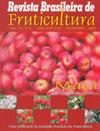香蕉对穴居线虫的水平和垂直抗性取决于线虫种群的侵袭性或毒性水平
IF 0.9
4区 农林科学
Q4 HORTICULTURE
引用次数: 0
摘要
穴居线虫是最具破坏性的病原体之一。抗性植物是线虫防治最有前途的方法之一,了解抗性和侵袭性成分对了解抗性遗传和培育新品种至关重要。因此,本研究旨在通过对8个香蕉材料对相似田鼠种群的抗性程度进行评估,以验证线虫种群间繁殖能力的差异,并研究Musa spp.和相似田鼠病理系统的水平/垂直抗性和侵袭性/毒力成分。将4249-05、479 -06、Yangambi Km5、0323-03、0337-02、1304-06、Borneo和Grande Naine分别接种来自巴西Pernambuco州、Distrito Federal州和Santa Catarina州的3个类群中的一个,并保存在温室中。4249-05、扬甘比Km5、0323-03和4279-06表现出不同程度的抗性,其中Pernambuco种群的繁殖能力最高。利用Griffing模型IV,观察到垂直和水平抗性的证据,其中4249-05和杨甘壁km5表现出最高的水平抗性。本文章由计算机程序翻译,如有差异,请以英文原文为准。
Banana horizontal and vertical resistance to the burrowing nematode depends on the level of aggressiveness or virulence of the nematode population
Abstract The burrowing nematode Radopholus similis is among the most damaging pathogens. Resistant plants are one of the most promising approaches for nematode control, and knowledge of resistance and aggressiveness components is essential to understand resistance genetics and developing new cultivars. Therefore, this study aimed to assess the degree of resistance of eight banana accessions to populations of R. similis to verify differences in the reproduction capacity between nematode populations and to study the horizontal/vertical resistance and aggressiveness/ virulence components of Musa spp. and R. similis pathosystem. The accessions 4249-05, 4279-06, Yangambi Km5, 0323-03, 0337-02, 1304-06, Borneo and Grande Naine were inoculated with one of three R. similis populations from the Brazilian states of Pernambuco, Distrito Federal, and Santa Catarina and kept in a greenhouse. Accessions 4249-05, Yangambi Km5, 0323-03, and 4279-06 showed different resistance levels, and the Pernambuco population had the highest reproductive capacity. Using Griffing Model IV, evidence of vertical and horizontal resistance was observed, with accessions 4249-05 and Yangambi km5 showing the highest levels of horizontal resistance.
求助全文
通过发布文献求助,成功后即可免费获取论文全文。
去求助
来源期刊
CiteScore
1.50
自引率
20.00%
发文量
34
审稿时长
4-8 weeks
期刊介绍:
The Revista Brasileira de Fruticultura (RBF) publishes technical articles and scientific communications in the area of fruit crops, referring to results of original searches and unpublished papers in Portuguese, Spanish or English, and 1 or 2 reviews per edition, of invited authors.

 求助内容:
求助内容: 应助结果提醒方式:
应助结果提醒方式:


